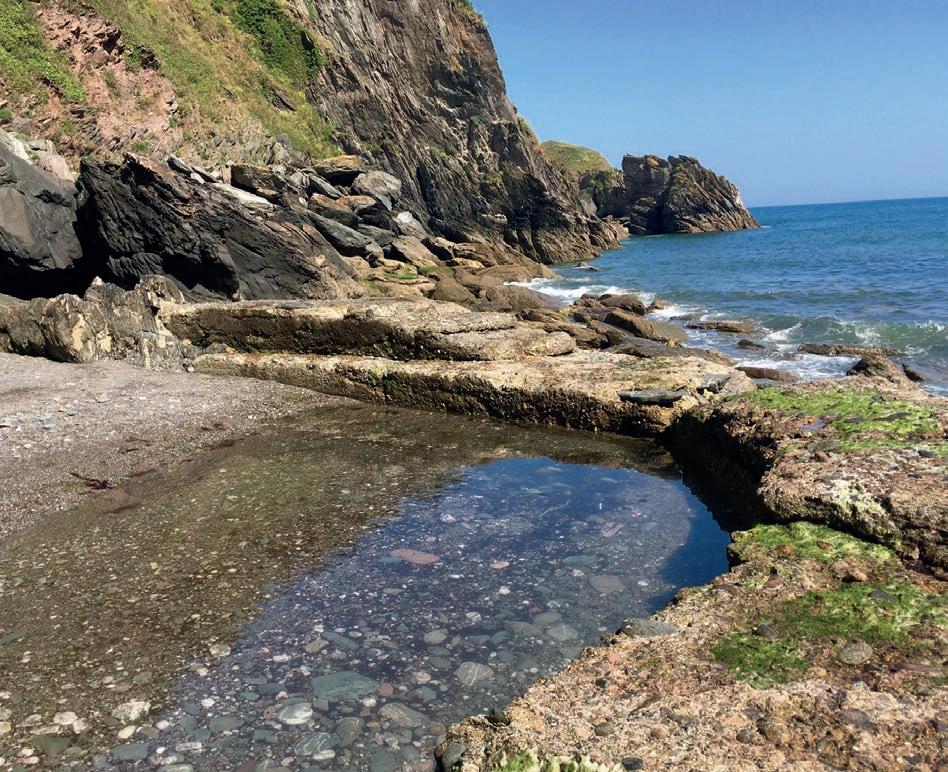
3 minute read
Jenny Ridd unlocks some family secrets
The D’Oyly Cartes at Pudcombe
Pudcombe Cove, once owned by the D’Oyly Carte family of Coleton Fishacre (now National Trust), had a seawater pool, a bathing hut and a yacht landing stage. is idyllic spot is no longer accessible on foot so Anita Newcombe lands by kayak to explore.
Advertisement
Rupert D’Oyly Carte of Gilbert & Sullivan and Savoy Hotel fame and Lady Dorothy, younger daughter of the Earl of Cranbrook spotted a beautiful valley leading down to the sea while out sailing and decided it was the perfect spot for an elegant country home, which they proceeded to have built in 1925. e wonderful gardens at Coleton Fishacre run down a narrow combe from the house to the sea at Pudcombe Cove. I decide to kayak there on a voyage of discovery.
Heading out of Dartmouth in one of Dartmouth Yacht Club’s sea kayaks (available to members who are competent paddlers), my kayaking buddy and I head downriver. We pass the Lower Car Ferry, the Royal Dart Yacht Club and paddle on towards Kingswear Castle. Mostly hugging the coastline, we continue on our way as the river mouth widens and we head round towards the Mew Stone. From here we can see the NCI Froward Point and we call them up on our handheld for a radio check. We’ve already checked the weather and tides and all is set fair for a favourable trip.
On the way, we enjoy pottering in and out of the rocky inlets until, before long we round the nal rocky outcrop and nd ourselves in sight of Pudcombe Cove. It’s a reasonable sized beach, very pretty and usually quite
The sea pool at Pudcombe Cove

sheltered – the high cli s that lead up the valley to Coleton Fishacre’s gardens protect an idyllic horseshoe-shaped cove.
No wonder the D’Oyly Cartes loved coming here. Of course, in those days there was a steep path down the cli s but it’s now completely eroded, cutting o access for anyone on foot. If you look at a satellite map though, you can still clearly see the seawater bathing pool that they used. As the tide comes in, the pool gradually lls and warms. It’s an idyllic place to sit and we take the opportunity to relax and contemplate what life must have been like for the family.
If you visit National Trust Coleton Fishacre, you’ll be able to see some fascinating evidence of their beach and sailing activities. e tidal clock near the front door would have told the D’Oyly Carte family when the next high tide was, and let them know when the lido at Pudcombe Cove could be used. ere is also a wind dial in the Library to forecast sailing conditions. Every day the butler would set the high tide clock manually as it had no mechanism. e National Trust still keeps a copy of the year’s tide tables in the Flower Room so that they can continue to do this today. ere is also a bell on the side of the house, which was used to call the family in from the cove at meal times.
Now I’m sitting on the edge of the seawater bathing pool with my toes in the water and I open my ask of tea and picnic sandwiches (no litter of course as I always use a Tupperware box). I’m pretty sure that the fare provided by the D’Oyly Carte’s butler would have been far superior; in fact local legend suggests that champagne was sometimes lowered over the cli down to the waiting recipients on the beach! ere was once a sailing jetty, sun bathing platform and shelter so it was the perfect spot for their favoured leisure activities. e tidal pool at Pudcombe Cove was probably built in the late 1920s or early 1930s; Lady Dorothy and Rupert D’Oyly Carte having moved into their newly built country home in 1926. It was a place they could entertain their guests in style.
Rupert and Bridget D’Oyly Carte surveying the building of Coleton Fishacre c.1925











